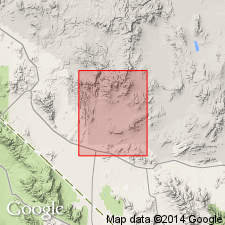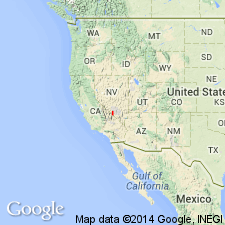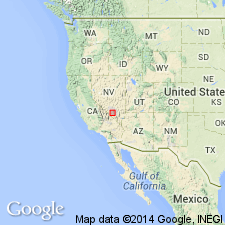
- Usage in publication:
-
- Tram Member*
- Modifications:
-
- Overview
- AAPG geologic province:
-
- Great Basin province
Summary:
Mapped as the basal member of Crater Flat Tuff southeast of Little Skull Mountain in south-central part of area in several small exposures, and in subsurface in a cross section, Nye Co, NV in the Great Basin province. Is an ash-flow tuff, a simple cooling unit, brown, gray, nonwelded to moderately welded, devitrified. Contains quartz, potassium feldspar, plagioclase, hornblende, biotite. Lithic content increases toward base. A 50 m thick reworked and bedded tuff at base. Maximum exposed thickness of 30+/-m. Is 269 m thick in subsurface. Is younger than the dacite lava and flow breccia in drillhole USW-G1. Is older than the Bullfrog Member of the Crater Flat Tuff. Reversed magnetic polarity. Miocene age.
Source: GNU records (USGS DDS-6; Denver GNULEX).

- Usage in publication:
-
- Tram Member*
- Modifications:
-
- Named
- Dominant lithology:
-
- Tuff
- AAPG geologic province:
-
- Great Basin province
Summary:
Named as the oldest ash-flow tuff of Crater Flat Tuff for exposures on north slope of Tram Ridge, Nye Co, NV in the Great Basin province. Type locality is along Beatty Wash and extends northeast from outcrops where Tram is unconformable on Lithic Ridge Tuff (new) and on unnamed rhyolite and quartz latite lavas under the Lithic Ridge. Top is eroded in upthrown fault block northwest of large caldera? fault under Tram Ridge. To southeast of fault, Tram is overlain by Paintbrush and Timber Mountain Tuffs. Minimum thickness estimated at 600 ft; thickness may be greater. In drillhole USW-G1, member is: 882+ ft thick; underlain by bedded tuff; overlain by bedded tuff beneath Bullfrog Member of Crater Flat. Distribution and thickness map. Geologic map. May extend as far west as Inyo Co, CA. Divisible into a lower lithic part that has abundant primarily rhyolitic and intermediate composition lava xenoliths and an upper part poorer in lithic fragments. Is difficult to distinguish from Bullfrog. Has more xenoliths than Bullfrog. In thin section modal analysis. Tram has more and slightly resorbed quartz phenocrysts than the Bullfrog. Has fewer spherulitic rhyolite phenocrysts than the Lithic Ridge. Has reverse remanent magnetism. Hydrothermally altered; therefore no K-Ar ages. Underlying Lithic Ridge dated at about 13.7 m.y. Lava beneath dated at 13.9 m.y. Stratigraphic chart.
Source: GNU records (USGS DDS-6; Denver GNULEX).

- Usage in publication:
-
- Tram Tuff*
- Modifications:
-
- Revised
- AAPG geologic province:
-
- Great Basin province
Summary:
Within southwest Nevada volcanic field, Nye Co, NV, Great Basin province, units previously of formation rank are raised to group rank to allow for combining petrographically, geochemically, and temporally related lava flows and nonwelded tuffs with the principal correlative welded ash-flow tuff sheets (formerly members of the previous formation-rank tuffs). The ash-flow sheets are raised to formation rank and designated as "Tuff." Tram is lowermost of three formally named formations of Crater Flat Group (rank raised). [Crater Flat also consists of informal units not discussed in this report.] Younger than Dead Horse Flat Formation (new) of Belted Range Group (rank raised); older than Bullfrog Tuff (rank raised) of Crater Flat. Nomenclature shown on table 1. Miocene age.
Source: GNU records (USGS DDS-6; Denver GNULEX).
For more information, please contact Nancy Stamm, Geologic Names Committee Secretary.
Asterisk (*) indicates published by U.S. Geological Survey authors.
"No current usage" (†) implies that a name has been abandoned or has fallen into disuse. Former usage and, if known, replacement name given in parentheses ( ).
Slash (/) indicates name conflicts with nomenclatural guidelines (CSN, 1933; ACSN, 1961, 1970; NACSN, 1983, 2005, 2021). May be explained within brackets ([ ]).

